Forests cover over thirty percent of the planet’s land surface, provide sustenance and medicine for 1.6 billion people, cool and infuse our air with oxygen and moisture, and shelter 80 percent of the world’s biodiversity. Yet every year, 15 billion trees are destroyed by subsistence farming practices, commercial logging, development, and a host of natural stressors.
Deforestation not only endangers endemic ecosystems and communities, but it also dramatically increases greenhouse gas emissions by releasing carbon dioxide stored in timber into the atmosphere. Despite enormous planting efforts, the planet still experiences a net loss of six billion trees annually.
Lauren Fletcher, CEO and Founder of U.K.-based startup BioCarbon Engineering, leaned on over 11 years of experience as an engineer at NASA to develop a faster, more efficient method of reforestation. His solution? Use drones to replenish our forests, one billion trees at a time.
Unreasonable sat down with Lauren to discuss working with astronauts, rebuilding Earth’s ecosystems, and refusing to take “no” for an answer.
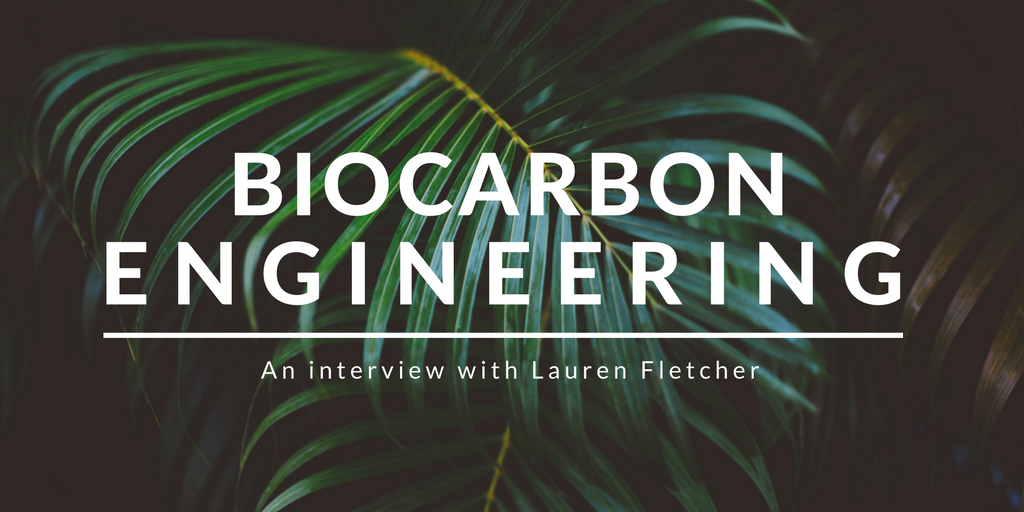
NASA seems like a great place to start… When did you know you wanted to become an engineer?
L: You know, I actually remember witnessing the first lunar landing. I was on my dad’s knee and he said, “Watch this.” So that was kind of the beginning of that deep connection to NASA, that deep interest in science and exploration and the desire to go out and do big things.
What stands out to you about that experience?
L: Well, I barely remember it, but it was in the years afterwards that everybody wanted to be an astronaut. And so I got that ingrained sense of, this is the coolest thing that the best of the best of the best get to do.
So how did you go from your father’s knee to kickstarting your own career in space programs?
L: Well, it was a mix of different experiences and opportunities. I actually grew up as a nationally ranked ski racer and had pursued that all the way up into the university level, just short of going for the U.S. ski team. And I got to the point where I had to make a decision between giving everything I had to make it to the Olympics, and seeing if I could make a semblance of a lifestyle on the sport, or investing myself elsewhere. I was watching friends walk off of the U.S. Ski Team and the first thing that they did was go off and pound nails, because they didn’t have an education. And that’s a hard life.
I made the decision to go and pursue an education. It still took a couple years to get over watching my friends at the Olympics and going, “I used to be that guy, damn.” It’s not so much of a regret, but it was a longing, because life only gives you so many windows to pursue those types of opportunities. So when I finally made the decision that I wanted to go work for NASA, I didn’t give them a choice. I used that life lesson of making a decision and not taking no for an answer and doing everything you can to make it happen.
What emboldened you to shoot for NASA?
L: I really liked space and I liked engineering. It was that simple. So I went down to NASA’s education department and I convinced them that they should take me. I should say that I begged. I went in and I was chatting with the woman who was in charge and she said, “I’m really sorry, but it’s not a requirement for you for your degree program so I’m probably not going to be able to offer you a position. I get 400 people a year and I have room for about 10. But since you’re here, why don’t you go talk to these departments.”
We all know that cutting down trees is a bad thing. But forests are so far away that it feels like somebody else’s problem. Tweet This Quote
So I went and interviewed three of the departments and figured out which one I wanted to work for, got their agreement, then got their boss’s approval, and then their boss’s boss’s approval, and then I went back to her and I said, “OK, I’m ready to come work. How do we get this going?”
And she goes, “But you realize I can’t give you an internship because it’s not a degree requirement.” And I just looked at her in the heartbreaking way you can when you’re 22 or 23, and she just didn’t know what to say. So she turned to her desk, she opened up her drawer, pulled out the form, and said, “OK, fill it out, tell me when you’re arriving.”
And that was my in. Then it was working 70 hours a week, but 70 hours a week passes so quickly when you’re working with great programs and great people, with astronauts running all over the place. I was starry-eyed. After two summers of that they offered me a job as a contractor, and I was with them ever since.
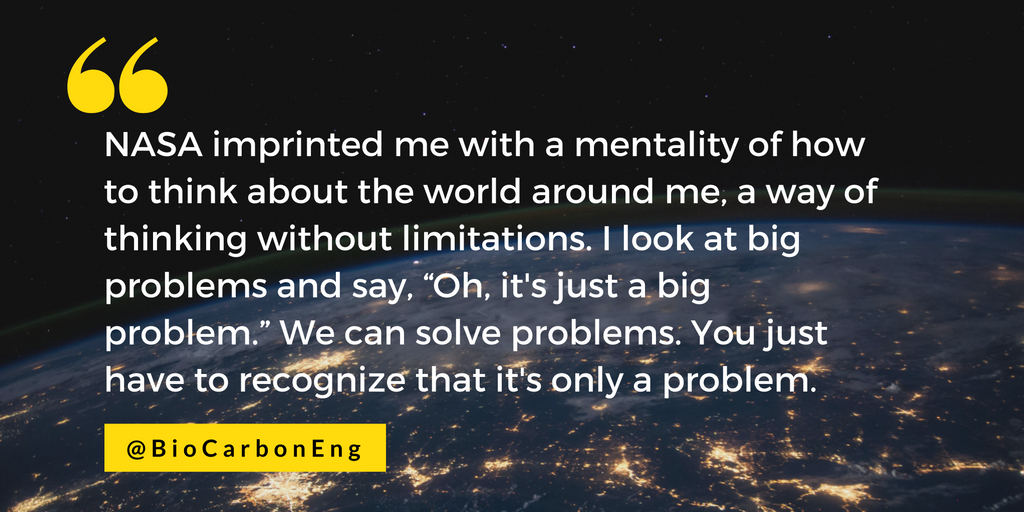
What’s your favorite part about working at NASA?
L: At the end of the day it’s the people. But there are so many incredible projects, too. I mean, we’re flying things to the International Space Station, or we’re thinking about getting stuff to Mars, or thinking about what a lunar base looks like. It’s very futuristic, big-picture thinking of working towards solving humanity’s greatest challenges. So NASA imprinted me with a mentality of how to think about the world around me, a way of thinking without limitations. I look at big problems and say, “Oh, it’s just a big problem.” We can solve problems. You just have to recognize that it’s only a problem.
How did you go from working in space programs to focusing on Earth-bound problems?
L: First I was working on shuttle missions with the astronauts, then on non-human life sciences programs, so research based around plants and fish and bird eggs and insects. It was the intersection between engineering and biology. After that I started working on advanced exploration technologies for Mars, and the search for life. How do we look for life? What’s it going to look like? What sorts of technologies do we need in order to discover life on Mars or elsewhere in our solar system?
Meanwhile, I was taking a masters degree program at Stanford University, where I was fortunate enough to take classes on climate change from Nobel laureates. In 2009 I attended COP21, the climate change conference in Copenhagen, and a main theme that year was deforestation. That was when I made the emotional connection to the loss of forests on Earth.
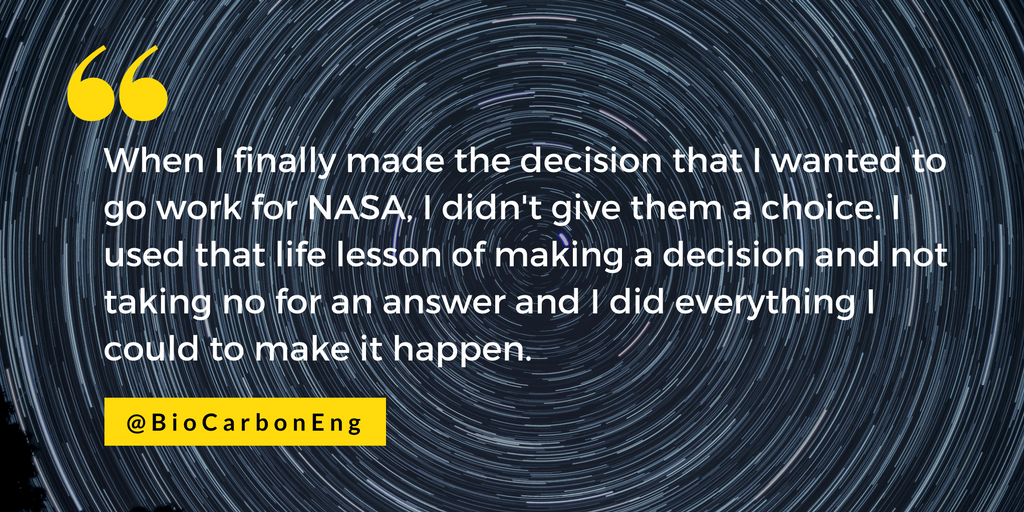
Why did you feel that you were capable of taking on an issue as immense as deforestation?
L: We all know that cutting down trees is a bad thing. But forests are so far away that it feels like somebody else’s problem. I need to feed the kids and I need to put food on the table and I need to get to work on time and oh, yeah, forests. You know? Cutting down trees is bad, but I need to get my mother to the doctor today. All of the real world tasks that consume our time make it easy to forget about global-scale problems.
When I made that strong emotional connection to the problem, I was able to recognize that forests are coming down really fast due to a host of mechanisms — everything from natural disasters, forest fires or floods, landslides, human uses from mining lumber, urban agricultural expansion — and I understood why we’re trying to squeeze every penny out of that resource. But I was really puzzled at why it takes so long to rebuild these ecosystems. It took almost no time to realize that it’s because the state of the art is some guy with a bag of saplings on his shoulder. And I thought, well, I work for NASA and we’ve got robotics and remote sensing and all these other technologies. We’ve got to do better than that. We can fix this problem.
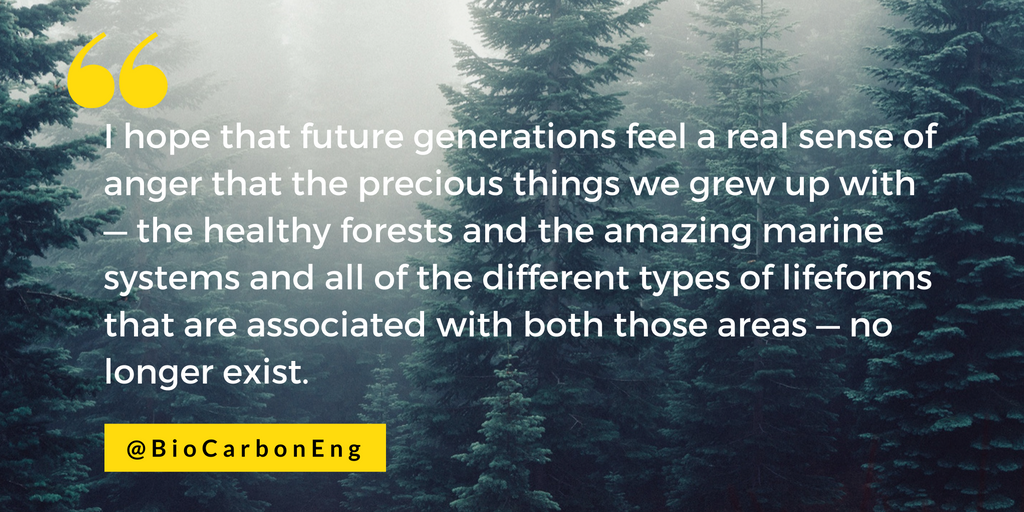
In what ways were you better positioned to address deforestation than others?
L: One of the advantages that I have as an outsider to the standard industry of reforestation is my exposure to lots of emerging technologies that the top level, brilliant, capable people in the forestry industry just haven’t seen yet, because they’re too close to the trees.
It was a convergence of technologies that emerged at the right time, combined with political and social recognition that this is a global-scale problem. Governments and large governmental organizations are making real commitments to restore and rebuild forests in global ecosystems. There’s money and political will and technology all converging at the right time and the right place and I was fortunate enough to recognize them for what they were and start to pull that idea together.
When we reforest areas near communities, they’ll be integrated into the entire process. Tweet This Quote
What we’re doing may be at the forefront in forestry, but there are other organizations that are looking at how to rebuild reef systems and the oceans. There are small groups of thought-leaders out there that are taking on these massive global problems that will fundamentally change the Earth and our well-being if we don’t address them and address them as fast as we can. And it has to be addressed in the right way. You have to take a look at the environment, the biology, and more importantly, the people, because this is ultimately about people.
Have you come up against any opposition?
L: We certainly have our critics and I have to say for all the articles that we get out there, probably the scariest thing to do is to look in the comments section. We get our doubters, on the technology side, the human element side, and the ecosystem side.
The technology has to be able to account for reestablishing an ecosystem in the right way. It needs to take into account natural species that actually combine to build a biodiversity that is appropriate for that location. And at the same time, it has to take into account the people who live in that location.
Who gets to say “I planted a billion trees?” That’s so awesome. I don’t care what anybody else says, that would be an amazing thing to be able to say. Tweet This Quote
In the world today, we look at the different types of uses of our landscapes and we have to think of them holistically, where you have natural forests and ecosystems that start to create ecosystem services. They regenerate the hydrological patterns and soil production and nutrient production, and then that all flows downhill and eventually permeates the agricultural plots, increasing their productivity. So there’s this direct link between getting all of those different land uses working together, and everything else follows: You have healthier people because they have better food, they have a healthier environment, you have reduced the amount of global warming because you’re going to naturally sequester significant amounts of CO2 when you get to this scale of planting trees, and ultimately, we all benefit.
It’s not just the one billion people who live in these forest communities who are affected. This affects everybody, from our global supply chain for the products that you and I rely on in our everyday life — food, clothing, the chairs that we’re sitting on now, medicines — all the way down to the people who live in those communities that rely on those ecosystems for their livelihood.
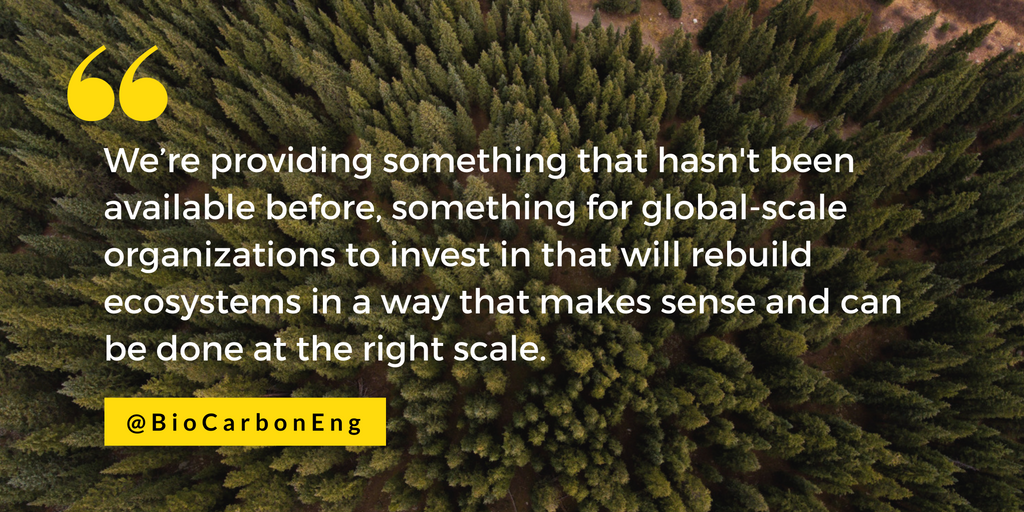
You mentioned the biodiversity and the nutrients of these ecosystems, and so I’m curious about the mapping process that has to happen before you can even begin planting and monitoring. How do you gather data about what is needed for that particular ecosystem and how it might filter down to nearby populations?
L: Our whole process is Big Data-driven. We start with satellite data sets and we use that for preliminary assessment of a large area to determine which places are appropriate for a reforestation project. The second phase is to go in with our mapping drones and take really high-resolution data that takes into account everything from topology and soil to the actual biodiversity of the region, and we use machine learning algorithms to match up appropriate species for each location. We have great ecologists on our team but they’re not necessarily knowledgeable about every specific location in the world, so part of our charter is to work with local ecologists for that species selection. As we’re building the map of how we want to reestablish an ecosystem, we collaborate with the local experts who know the area best.
How does planting trees near a community that’s experienced fallow fields as a result of over-fertilizing, poor agricultural practices, or deforestation help that community?
L: When we reforest areas, especially near communities, they’ll be integrated into the entire process, and that’s really important because we rely on them for some very key activities. The first is that we have to actually use local seeds for the species that we’re going to produce, because a pine is not always a pine, and there can be some differences in how they germinate or activate gene sets.
Our job is to make trees grow. Full stop. Technology is an aid to do that at great scales. Tweet This Quote
Then we involve communities in the manufacturing process, because we have to create seed pods with the germinated seed and the necessary nutrients. Then those go into the planting drone and are planted according to the pattern that was developed in collaboration with the local community and local ecologists.
And then afterwards, if the planted area is nearby a community, they’ll be involved in the post-planting maintenance and monitoring so that they can ensure the growth of a healthy ecosystem. And in some cases it may not be 100 percent about building a natural ecosystem; You may take a look at specific species that could provide raw materials that community can then use for food or for generation of new products to sell elsewhere.
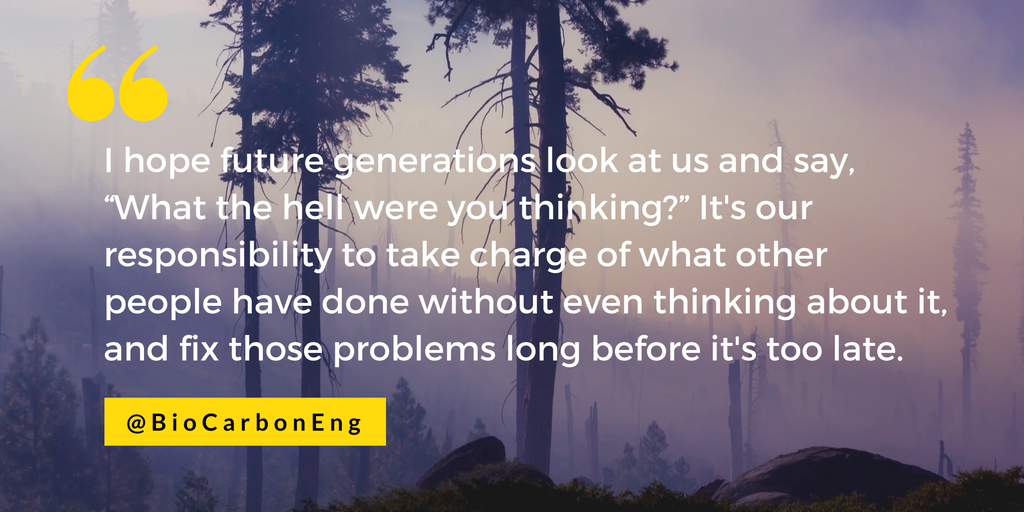
Will planting an enormous number of trees place strains on water resources?
L: If you establish a large forest system, it will actually change the local hydrological patterns and atmospheric circulation patterns. By building up those forests, what you find is that the trees are dropping the surface temperature, which is actually pulling in atmospheric moisture, which in turn starts that hydrological cycle. You are actually making it a much moister system that can support other species, whereas deforestation makes it much drier.
What are some of the biggest challenges that you are facing as a company right now?
L: Our biggest challenge is always getting more species into the mix so that we can address larger ecosystems with a higher level of biodiversity. Our job is to make trees grow. Full stop. Technology is an aid to do that at great scales. Our drones happen to be the tool to allow us to address large areas, but we’re really there to plant the trees and build those ecosystems and provide tools that allow people to be more efficient and effective at doing that task.
Video courtesy of BioCarbon Engineering.
How did you land on the concept of using drones to plant trees, and how did you go about developing the technology?
L: The development of the technology was from a number of past experiences, but most importantly it was a knowledge and understanding in how to combine emerging technologies in robotics, remote sensing, and machine learning. Drones was the piece that just fit in at the right place at the right time.
We imagine a world that is healthy, that has lush, green environments and forests. Tweet This Quote
I kept thinking, if the state of the art is planting by hand and that’s the only option, how do I provide a tool to allow people to be more effective and efficient? How do I automate that in a way that makes sense? And because most forest areas are not nice, flat areas where ground-based machinery is going to work well, we have to come up with a different type of approach that will allow them to get into those remote and difficult to reach places.
And if I want precision planting from an aerial platform, that means I need to have some kind of a system that’s going to recognize where I’m at and whether or not that is a good place to plant a tree or not. So Big Data gets pulled in.
Drones can’t carry a lot of mass, so instead of saplings, we work with seeds, which lowers the size and weight requirements. And so I just kept combining all of these factors and eventually arrived at a solution.
Are there any companies doing similar work? What’s your differential?
L: There are a number of copycats coming along. We’re first movers, so we are the ones that are out in front. We’re getting recognized and pulled into conversations at the UNCCD, UNEP, by the World Resources Institute, the WWF. Great, amazing organizations. We’ve been very fortunate to capture their attention, because we’re providing something that hasn’t been available before, something for global-scale organizations to invest in that will rebuild ecosystems in a way that makes sense and can be done at the right scale.
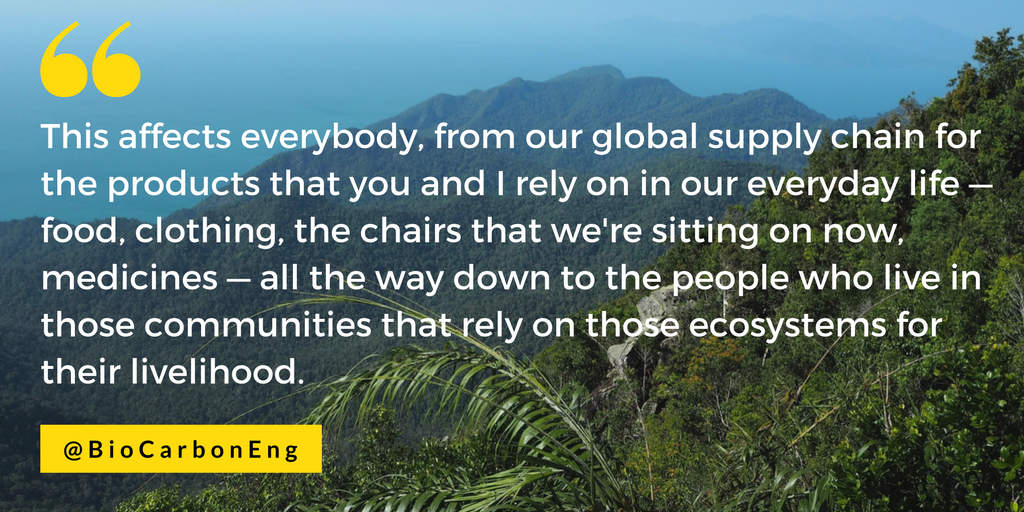
Do you believe that you can succeed in impacting deforestation on the scale that you want to?
L: This is a great opportunity and there is no reason why we can’t scale it. It’s a matter of getting the planting right. We get the planting right and then the rest will just follow.
What do you hope that the world will look like as a result of BioCarbon Engineering’s success?
L: We imagine a world that is healthy, that has lush, green environments and forests. So much has been degraded or lost over the last couple of centuries and we have to make it a priority to restore our environment. The only way to do that is to innovate and come up with new technology approaches that takes into account the biology and the people affected.
What do you think the Moon Landing moment will be that inspires the next generation in the same way you were inspired as a child?
It’s not just the one billion people who live in these forest communities who are affected by deforestation. Tweet This Quote
L: It’s hard to say, but I would really hope that our future generations experience not only a frustration, but a real sense of anger that my generation allowed the Earth to almost die, that the precious things we grew up with — the healthy forests and the amazing marine systems and all of the different types of lifeforms that are associated with both those areas — no longer exist. I hope future generations look at us and say, “What the hell were you thinking?” It’s our responsibility to take charge of what other people have done without even thinking about it, and fix those problems long before it’s too late.
Going back to your ski days, what would you say your next gold medal will be?
L: Next gold medal is planting a billion trees. Yeah, we do that then that would be absolutely amazing. I mean come on, who gets to say “I planted a billion trees?” That’s so awesome. I don’t care what anybody else says, that would be an amazing thing to be able to say.
This company participated in Unreasonable Impact created with Barclays, the world’s first multi-year partnership focused on scaling up entrepreneurial solutions that will help employ thousands while solving some of our most pressing societal challenges.



